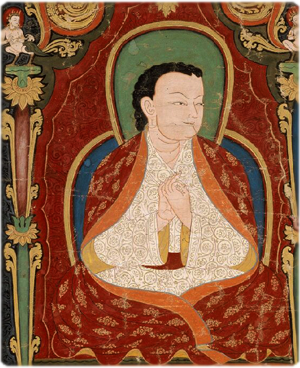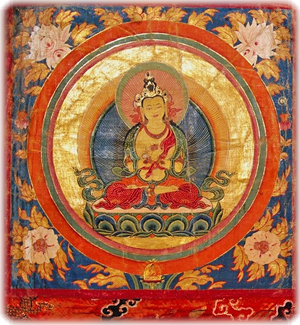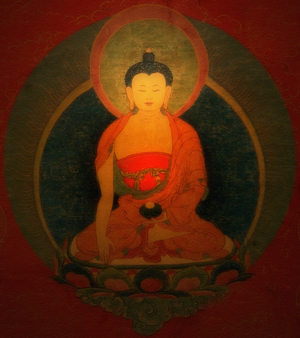Buddhist Tantra: Some Introductory Remarks
His Holiness Sakya Trizin
There is a common misconception among many non-Buddhists (and even among certain Buddhists) that the Tantras are late and corrupt additions to the Buddha's Teachings. This is false. The Tantras are genuine teachings of the Lord Buddha, and they occupy a paramount position within the overall framework of Buddhist doctrine.
Some of the misconceptions about the Tantras stem from their esoteric nature. Since the time of the Buddha the Tantras were always taught secretly and selectively. For their correct understanding they have always required the oral instructions of a qualified master; without such explanations they can easily be misunderstood in wrong and harmful ways. In order to uphold this tradition I am prevented from discussing most aspects of Tantra here. But it is perhaps permissible here to say a few general things about Buddhist Tantra and about how it is related to other systems of Buddhist and non-Buddhist thought and practice. I shall base myself on the teachings of our tradition such as the Rgyud sde spyi'i rnam gzhag ("General System of the Tantras") of Lobpon Sonam Tsemo.
WHAT IS TANTRA?
In Tibetan tradition the word Tantra (rgyud) nomrally refers to a special class of the Buddha's teachings like the Kriya, Carya, Yoga and Anuttarayoga Tantras, and more specifically to the scriptures that embody it, such as the Hevajratantra, the Kalacakratantra, and the Guhyasamajatantra. But contrary to its English usage, the word does not usually refer to the whole system of Tantric practice and theory. For the doctrinal system of Tantra, the terms Mantrayana ("Mantra Vehicle") and Vajrayana ("Vajra" or "Adamantine Vehicle") are used instead.
In its technical sense, the word Tantra means "continuum". In particular, Tantra refers to one's own mind as non-dual Wisdom (jnana); it exists as a continuum because there is an unbroken continuation of mind from beginningless time until the attainment of Buddhahood. This continuum, moreover, has three aspects or stages; the causal continuum, the continuum involved in applied method, and the resultant continuum. Sentient creatures in ordinary cyclic existence (samsara) are the "causal continuum". Those who are engaged in methods of gaining liberation are the "continuum involved in the method". And those who have achieved the ultimate spiritual fruit, the Body of Wisdom, are the "resultant continuum". The causal continuum is so called because there exists in it the potential for producing a fruit is not actually manifested. It is like a seed kept in a container. "Method" is so called because there exists means or methods by which the result latent in the cause can be brought out. "Method" is like the water and fertilizer needed for growing a plant. "Fruit" or "result" refers to the actualization of the result that was latent in the cause. This is like the ripened flower that results when one has planted the seed and properly cultivated the plant.
THE PLACE OF TANTRA IN THE BUDDHIST TEACHINGS 
In His infinite compassion, wisdom and power, the Lord Buddha gave innumerable different teachings aimed at helping countless beings of different mentalities. These teachings can be classified into two main classes: 1) the Sravakayana (which includes the present Theravada), and 2) the Mahayana. The Sravakayana (sometimes also called the Hinayana) is mainly aimed at individual salvation, which the Mahayana stresses the universal ideal of the Bodhisattva ("the Being intent upon Enlightenment") who selflessly strives for the liberation of all beings, vowing to remain in cyclic existence until all others are liberated. The Mahayana or Great Vehicle can also be divided into two: 1) the Paramitayana ("Perfection Vehicle") which we also call the "Causal Vehicle" because in it the Bodhisattva's moral perfections are cultivated as the causes of future Buddhahood, and 2) the Mantrayana ("Mantra Vehicle"), which is also known as the "Resultant Vehicle" because through its special practices one realizes the Wisdom of enlightenment as actually present.
THE SPIRITUAL FRUIT TO BE ATTAINED THROUGH TANTRA
The spiritual fruit that is aimed at in both branches of Mahayana practice is the Perfect Awakening or Enlightenment of Buddhahood. A Perfectly awakened Buddha is one who has correctly understood the status of all knowable things in ultimate reality, who possess consummate bliss that is free from the impurities, and who has eliminated all stains of the obscurations. The latter characteristic - the freedom from the obscurations - is a cause for other features of Buddhahood. It consists of the elimination of three types of obscurations or impediments: those defilements such as hatred and desire, those that obscure one's knowledge of reality as it is and in its multiplicity, and those that pertain to the meditative attainments.
THE PATH THAT LEADS TO THE FRUIT
We speak of a method of spiritual practice as a "path" because it is a means by which one reaches the spiritual destination that one is aiming at. There are two types of path. One consists of the common paths that lead to inferior results, and the other is the extraordinary path that leads to the highest goal.
INFERIOR PATHS
Some religions or philosophical traditions while claiming to yield good results actually lead their practitioners to undesirable destinations. For instance, the inferior Tirthikas (non-Buddhist Indian schools) as well as those who propound Nihilism only lead their followers to rebirths in the miserable realms of existence. The higher Tirthikas can lead one to the acquisition of a rebirth in the higher realms, but not to liberation. And even the paths of Sravakayana and Pratyekabuddhayana are inferior, for they lead only to simply liberation, and not to complete Buddhahood.
THE SPECIAL PATH
The special path is the Mahayana. It is superior to both non-Buddhist paths and the lower Buddhist paths for it alone is the means by which perfect Buddhahood can be attained. It is superior to all other paths for four particular reasons. It is a better means for removing suffering, it is without attachment to cyclic existence, as a method of liberation it is the vehicle of Buddhahood, and it does not desire only liberation for it is the path of existence and quiescence equally, in which emptiness and compassion are taught as being non-dual.
THE DIVISIONS OF THE MAHAYANA
The Mahayana itself has two major divisions. As mentioned above, these are the Perfection Vehicle and the Secret-Mantra Vehicle. The first of these is also termed the general Mahayana because it is held in common with both Mahayana divisions, whereas the second is termed the particular because its special profound and vast doctrines are not found within the general tradition. The two vehicles derive their names from the practices predominating within them. In the Perfection Vehicle, the practices of the Bodhisattva's perfections (paramita) predominate, and in the Secret-Mantra Vehicle the practices of mantra and related meditations, such as the two stages of Creation and Completion in visualizing the Mandala and the Deity, the mantra recitation and various secret and profound yogas, predominate.
One essential difference between the two Mahayana approaches can be explained by way of their approach to the sensory objects which are the basis for both cyclic existence and Nirvana. In the Perfection Vehicle one tries to banish the five classes of sensory objects outright. One first restrains oneself physically and verbally from overt misdeeds regarding the objects of sense desire, and then through texts and reasoning one learns about their nature. Afterwards through meditative realization one removes all of one's attachment to them. This is done on the surface level through meditatively cultivating the antidote to the defilements, such as by cultivating love as antidote to anger, and a view of the repulsiveness of the sense objects as the antidote to desire. And on the ultimate level one removes one's attachment through understanding and meditatively realizing that all of these objects in fact are without any independent self-nature.
In the Mantra Vehicle, too, one begins by restraining oneself outwardly (the essential basis for one's conduct is the morality of the Pratimoksa and Bodhisattva), but in one's attitude toward the sense objects one does not try to eliminate them directly. Some will of course object that such objects of sensory desire can only act as fetters that prevent one's liberation, and that they must be eliminated. Though this is true for the ordinary individual who lacks skillful methods, for the practitioner who possesses skillful means, those very sense objects will help in the attainment of liberation. It is like fire which when out of control can cause great damage, but when used properly and skillfully is very beneficial. While for lower schools the sense objects arise as the enemies of one's religious practice, here they arise as one's teachers. Moreover, sense objects do not act as fetters by their natures, rather, one is fettered by the erroneous conceptual thoughts that are based on them.
THE SUPERIORITY OF VAJRAYANA OVER PARAMITAYANA
The Secret-Mantra Vehicle is superior to the Perfection Vehicle from several points of view, but its superiority primarily rests in the greater efficacy and skillfulness of its methods. Through Mantrayana practices, a person of superior faculties can attain Awakening in a single lifetime. One of middling faculties can attain Awakening in the after-death period (bardo). And one of inferior faculties who observes the commitments will attain enlightenment in from seven to sixteen lifetimes. These are much shorter periods than the three "immeasurable" aeons required through the Paramitayana practices. But even though the Mantra Vehicle is thus superior in skillful methods, its view of ultimate reality is identical with the Madhyamika view of the general Mahayana. For both schools the ultimate reality is devoid of all discursive developments or elaborations (nisprapanca). One view cannot be higher than the other since "higher" and "lower" are themselves but discursive developments or conceptualizations.
PREPARATIONS AND PREREQUISITES FOR TANTRIC PRACTICE
The foregoing has been a general introduction to a few of the basic ideas of Buddhist Tantra. The real question is how to apply these theoretical considerations in a useful way, that is, how to practice them. The practice of Mantrayana and further in-depth study of its philosophy requires first of all a special initiation from a qualified master.
IMPORTANCE OF THE GURU
One must seek and carefully choose a Guru who has all the qualifications to teach the Tantras; for instance, he himself must have received all the necessary initiations and explanations from a qualified Teacher, done long retreats, and learned all the rituals, mudras, drawing of Mandalas, etc. He must also have received signs of spiritual attainments. It is also very important to find a Guru with whom one has a connection by karma. In any case, it is imperative to find a Guru, and one should not practice without a teacher, especially within the Vajrayana. One cannot get any result by merely studying a text. It is said in the Tantras that the Guru is the root and source of all the siddhis and of all realization.
QUALITIES OF THE DISCIPLE
Before one can be initiated, one will first be examined by the teacher who will ascertain whether one is a fit receptacle for the teachings. The main qualities required are faith, compassion and Bodhicitta (the Enlightenment Thought). A major empowerment is never given to those who have not developed Bodhicitta to a higher degree. In this way both the student and the teacher must examine each other carefully.
IMPORTANCE OF THE TRANSMISSION
When the right Guru is found, one should then request him for initiation and explanations. In Vajrayana it is necessary to receive the Wangkur (Empowerment or Initiation), the transmission or permission to practice the Tantra, without which one cannot practice anything. The transmission is particularly important in Vajrayana, and the Lama (Guru) assures the continuity of a line of direct transmission through a succession of teachers. This line of transmission has been unbroken since the Lord Sakyamuni Buddha set into motion the Wheel of Dharma. Not only must there be this line of Transmission, but also there must be a line of practice that has kept the lineage alive.
VOWS AND PRACITCE
After one has been led into glorious mandala by the master, one begins one's practice, carefully observing the various vows and commitments of the Vajrayana. These vows are primarily mental, and as such they can be even more difficult than those of the Pratimoksa and Bodhisattva systems. One must also devote oneself to further study, and to practicing the specialized visualizations and yogas according to the master's instructions.
BUDDHIST VERSUS HINDU TANTRA 
Buddhist Tantra is thus distinguished from the other branches of Mahayana by its special methods. It is, however, identical to the Mahayana Madhyamika in its ultimate view, and it is the same as all Mahayana schools regarding its aim and motivation. Hindu Tantra by contrast has a different philosophical basis and motivation, even though it shares some of the same practical methodology. Some persons must have suggested that Buddhist Tantra must not belong to pure Buddhism because it shares many elements of practice within the Hindus. This is specious reasoning because certain methods are bound to be shared by different religious traditions. Suppose we had to abandon each and every element of practice shared with Hindu traditions. In that case we would have to give up generosity, morality, and much more!
There are of course many further differences between Buddhist and Hindu Tantra in their meditative practices, and so forth. But I shall not attempt to explicate them since my own first-hand knowledge is limited to the Buddhist tradition. Here it will be enough to stress that Buddhist Vajrayana presupposes the taking of refuge in the Buddha, Dharma and Sangha (and the Guru as the embodiment of those three), the understanding of Emptiness (sunyata), and the cultivation of love, compassion and Bodhicitta (the Enlightenment Thought). And I must again underline the importance of Bodhicitta, which is the firm resolve to attain perfect Buddhahood in order to benefit all sentient creatures, through one's great wish that they be happy and free from sorrow. These distinguishing features are not found in the non-Buddhist Tantras.
CONCLUSION
The study of Tantra can only be fruitful if one can apply it through practice, and to do this one must find, serve and carefully follow a qualified master. If one finds one's true teacher and is graced by his blessings one can make swift progress towards the goal, Perfect Awakening for the benefit of all creatures. In composing this account I am mindful of my own immeasurable debt of gratitude of my own kind masters. Here I have tried to be true to their teachings and to those of the other great masters of our lineage without divulging that which is forbidden to be taught publicly. I will consider my efforts to have been worthwhile if some harmful misunderstandings have been dispelled.
May all beings come to enjoy the true happiness of Buddhahood! |

